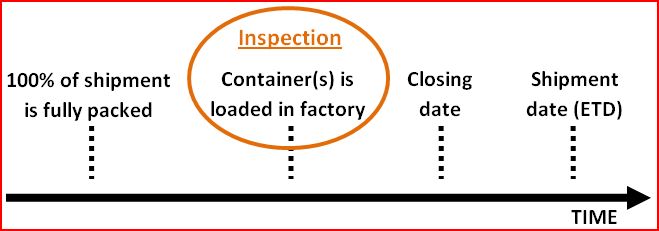 A lot of things can go wrong when a shipment is loaded in a container, or during transport. A good solution is to send a technician conduct a container loading inspection. For some urgent shipments, it is performed in combination with a final random inspection (see the list of the main types of quality inspection services).
A lot of things can go wrong when a shipment is loaded in a container, or during transport. A good solution is to send a technician conduct a container loading inspection. For some urgent shipments, it is performed in combination with a final random inspection (see the list of the main types of quality inspection services).
The container loading inspection is not used as frequently as the final inspection, but I met some buyers who only perform this type of quality check. For most importers, it is reserved for the most sensitive shipments.
When to conduct a container loading inspection?
It usually takes place in the factory, when the products are loaded in container(s), in the exporting country.
Obviously, the whole shipment quantity should already be fully packed.
Here is a little sketch that shows the key dates to watch closely:
What is checked at the time of the loading of container(s)?
1. Conformity of products
The inspector can arrive a little in advance, open a few cartons, and check if the products and the inner packing are conform to what the buyer is expecting.
The objective is to ensure that the right kind of goods is shipped out. Of course he can only check a few samples of each SKU, so he might not notice if 30% of the quantity is broken. That’s why a random inspection on a higher number of samples (during production and/or after all is finished) is advised.
2. Outer packing
A quick look at the condition of export cartons is a must. The cartons might be very soft because of the wet weather, or already crushed/bulged, or not properly closed–these are all red flags for the buyer. What will cartons look like after several weeks in a container, and a few loadings/unloadings in trucks and distribution centers?
Other packing materials might be requirement by the buyer: palets, plastic wrap, etc. And for some large or fragile products, some dunnage (eg. inflatable bags, kraft paper…) might be necessary. Factories are always tempted to save a few pennies on such accessories, with potentially disastrous consequences.
3. Total quantity and breakdown
The inspector can count the whole quantity–it should be easy since it should all be packed in cartons. The number of cartons appears on the bill of lading issued by the forwarder, but this type of inspection also ensures that cartons contain the right quantity (and, if applicable, the right mix) of products.
4. The container(s)
When truck(s) arrive, the inspector takes a few minutes and examines the container(s) condition. If he sees potential leaks or other issues, he should report it immediately and (if possible) ask for another container.
5. The handling and the loading process
The inspector supervises the loading. The buyer might have sent a loading plan, or some simple directives (e.g. “the heaviest cartons at the bottom”).
He also makes sure the factory workers try to make all cartons fit nicely in the container. Sometimes they don’t take this pain, and they end up pushing (and crushing) cartons with a forklift…
6. The seal
The inspector verifies that a proper seal closes the container before the products are driven away from the factory. It also protects the exporter (under FOB or EXW terms), as it clarifies the responsibility of the forwarder.
When are container loading inspections the most useful?
- If the loading way absolutely has to be respected (for example, jackets placed inside a plastic film and then hung up on racks);
- If products from different suppliers are consolidated by the buyer (or his local agent) into full containers: it is important to check who brings what quantity of products;
- If the buyer does not trust his supplier at all, and is afraid that the wrong type of products will be shipped out;
- If the outer packing will be used as retail packing (a flooded container might be disastrous).
What are the limits of a container loading inspection?
- As noted above, it is not a replacement for more in-depth inspections.
- It can only be used for confirming product quality (because nothing can be repaired at this stage, unless shipment is suspended) and for putting pressure on the factory to load properly.


i receive your inspection tips,maybe cant help me to inspect container. i like this tips
Hi Kalmisam, thanks for your comments, and feel free to contact us if you need assistance.
This instruction is very helpful for me in preparing internal guideline of container loading supervision. Thank you for your article
Thom,
You are most welcome!
Respected sir,
Can u give me deatail of differnt type of stuffung process which are use for only agriculture cargos.
Hi Hiral,
Unfortunately I have no idea. I don’t work on agricultural products.
thanks for the tips, may i ask you if you know any inspection company in egypt to inspect some goods to import into my country???????
Carolina,
I don’t know any, sorry…